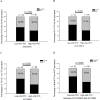Associations of melatonin receptor gene polymorphisms with Graves' disease
- PMID: 28961261
- PMCID: PMC5621676
- DOI: 10.1371/journal.pone.0185529
Associations of melatonin receptor gene polymorphisms with Graves' disease
Abstract
Background: Melatonin plays an important role in immunity and has been linked to autoimmune diseases. Possible associations of single-nucleotide polymorphisms (SNPs) of melatonin receptor type 1A (MTNR1A) and 1B (MTNR1B), with autoimmune thyroid disease in an ethnic Chinese (i.e., Taiwanese) population were examined.
Materials and methods: Totally, 83 Hashimoto's thyroiditis patients, 319 Graves' disease (GD), and 369 controls were recruited. Three SNPs (rs6553010, rs13140012, and rs2119882) of MTNR1A and three SNPs (rs1387153, rs10830963, and rs1562444) of MTNR1B were genotyped.
Results: There were a reduced frequency of the C allele of rs2119882 and a reduced percentage of the CC+CT genotype in the GD group compared to the control group (p = 0.039, odds ratio (OR) = 0.79, 95% confidence interval (CI) = 0.63~0.99, and p = 0.032, OR = 0.72, 95% CI = 0.53~0.97, respectively). There was a significant difference in the percentage of the AT haplotype of the combination of rs13140012 and rs2119882 between the GD and control groups (p = 0.010, OR = 1.34, 95% CI = 1.07~1.67). In addition, there were significant associations of anti-thyroid peroxidase antibody titers with rs13140012 and rs2119882, and the AATT genotype of the combination of rs13140012 and rs2119882 (p = 0.003, 0.003, and 0.004, respectively). There were no significant associations of SNPs and possible haplotypes of MTNR1B with susceptibility to GD.
Conclusions: Genetic variants of rs2119882 of MTNR1A and the AT haplotype of the combination of rs2119882 and rs13140012 were associated with GD susceptibility in an ethnic Chinese population. The results support the involvement of the melatonin pathway in the pathogenesis of GD.
Conflict of interest statement
Figures


References
-
- Reiter RJ Mechanisms of cancer inhibition by melatonin. J Pineal Res 2004;37: 213–214. doi: 10.1111/j.1600-079X.2004.00165.x - DOI - PubMed
-
- Malpaux B, Migaud M, Tricoire H, Chemineau P Biology of mammalian photoperiodism and the critical role of the pineal gland and melatonin. J Biol Rhythms 2001;16: 336–347. doi: 10.1177/074873001129002051 - DOI - PubMed
-
- Jimenez-Caliani AJ, Jimenez-Jorge S, Molinero P, Guerrero JM, Fernandez-Santos JM, Martin-Lacave I, et al. Dual effect of melatonin as proinflammatory and antioxidant in collagen-induced arthritis in rats. J Pineal Res 2005;38: 93–99. doi: 10.1111/j.1600-079X.2004.00175.x - DOI - PubMed
-
- Manchester LC, Coto-Montes A, Boga JA, Andersen LP, Zhou Z, Galano A, et al. Melatonin: an ancient molecule that makes oxygen metabolically tolerable. J Pineal Res 2015;59: 403–419. doi: 10.1111/jpi.12267 - DOI - PubMed
-
- Miller SC, Pandi-Perumal SR, Esquifino AI, Cardinali DP, Maestroni GJ The role of melatonin in immuno-enhancement: potential application in cancer. Int J Exp Pathol 2006;87: 81–87. doi: 10.1111/j.0959-9673.2006.00474.x - DOI - PMC - PubMed
MeSH terms
Substances
LinkOut - more resources
Full Text Sources
Other Literature Sources

